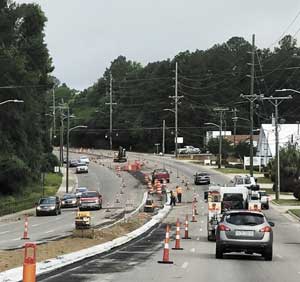 On June 29, 1956, President Dwight Eisenhower signed the Federal-Aid Highway Act of 1956, making medians part of the American highway landscape. The bill created a 41,000-mile “National System of Interstate and Defense Highways” that would, according to Eisenhower, eliminate unsafe roads, inefficient routes, traffic jams and all the other things that got in the way of “speedy, safe transcontinental travel.”
On June 29, 1956, President Dwight Eisenhower signed the Federal-Aid Highway Act of 1956, making medians part of the American highway landscape. The bill created a 41,000-mile “National System of Interstate and Defense Highways” that would, according to Eisenhower, eliminate unsafe roads, inefficient routes, traffic jams and all the other things that got in the way of “speedy, safe transcontinental travel.”
Today, you only have to drive a few miles to know that Fayetteville is taking road medians to a new level. These medians are still under construction, which means these areas are dangerous to everyone — particularly motorcyclists.
Road construction demands orange cones, barrels, debris and drivers making sudden stops. I was on Bragg Boulevard the other day and within seconds, a cone was out into the lane. A police car was there attending an accident, because someone rear-ended the car in front of them while making a left-hand turn. Combine all of this with large machines kicking up asphalt, and you’ve got a recipe for a motorcycle danger zone.
As good motorcyclists, we have to pay attention to our surroundings. We know we have a limited time to react when an event happens. As riders, we have one goal in order to stay safe: maintain the space around us.
In order get that space, we must be ready to be able to stop and stop suddenly. It is important to note that many modern motorcycles have Anti-lock Brake System. Based on information from wheel speed sensors, the ABS unit adjusts the pressure of the brake fluid in order to keep traction and avoid fall downs (e.g. maintain deceleration). On bikes without ABS, riders must use their skills to provide balance between the front and back brakes.
How long does it take to stop? Reaction times depend on two major factors: the bike and the rider.
It takes an alert, experienced rider a little less than a second to process the situation. To be a little more precise, it takes about 0.7 seconds with good brakes, good tires, a smooth surface and a dry road to maximize your braking distance. This is assuming that the motorcyclist has their hands over the front brake and the foot in the ready position to press down on the rear brake. For a less experienced motorcyclist, it can take from 1.0 to 1.5 seconds to react — if they react at all.
Let’s say it takes 1.25 seconds before you react to danger. Going 40 mph, it can take 74 feet just to react. At 40 mph, under good conditions, it can take another 2.15 seconds to go from 40 mph to a stop. That is a traveling distance of 62 feet to stop. This is a total of 136 feet for a total of 3.75 seconds to come to a stop.
In normal traffic, we are taught to stay at least two seconds behind the vehicle in front of you. This means you have a 1.75 second gap, and you will hit whatever it is that you are trying to avoid.
If you can’t avoid crashing, what do you do? Some suggest standing up and leaping in hopes hope you can fly over the obstacle. Others say to lay the bike down and slide towards the obstacle. Either way, you still have to contend with speed, force and the impact of the ground, and then possibly the obstacle.
Somewhere, your body will have to absorb the impact. The best thing to do is to avoid this situation all together, but if you are going to crash, you still have time lay on the brakes and let technology continue to slow you down. It is better to hit at something 5 mph than 25 mph.
If you have been reading my articles for any time, you know I am a big believer in riding with the proper riding gear: DOT full face helmet, eye protection, motorcycle jacket, motorcycle pants, boots and gloves. If you do hit, you will thank me for the reminder.
Stay safe and keep the rubber down. If there is a topic that you would like to discuss you can contact me at motorcycle4fun@aol.com. RIDE SAFE!